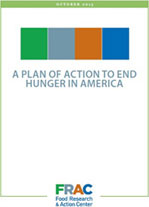Media Contact:
Emily Pickren
epickren@frac.org
202-640-1118
WASHINGTON, February 20, 2018 — Households in rural areas and small towns continue to be more likely to receive assistance from the Supplemental Nutrition Assistance Program (SNAP) than their metro area counterparts, according to the Food Research & Action Center’s (FRAC) updated analysis of the most recent U.S. Census Bureau data on SNAP participation. SNAP Maps, FRAC’s interactive data tool, shows that, on average, from 2012–2016, 15.8 percent of rural households and 15.3 percent of households in small towns nationwide participated in SNAP, compared to 12.6 percent of households in metro areas across the country.
“SNAP serves as the first line of defense against hunger and is critical to keeping and lifting low-income households — including large numbers in rural and small town areas — out of poverty and hunger,” said Jim Weill, president, FRAC. “SNAP is one of the nation’s very best investments, and it is unacceptable that this proven and effective program, with its widespread reach, is under attack.”
Under the president’s proposed fiscal year 2019 budget, households getting more than $90 a month in SNAP would receive a monthly box of government-selected, nonperishable foods, dubbed “America’s Harvest Box,” in lieu of benefits on an EBT card. This adverse structural change would not only harm rural and small town economies, it would be administratively costly, inefficient, stigmatizing, and prone to failure — making hunger and poverty in these areas far worse.
“SNAP gives rural and small town areas an economic boost,” added Weill, noting that every dollar spent in SNAP benefits generates approximately $1.79 in economic activity. “SNAP means more money for local grocers, and more markets for farmers.”
More than 1,000 anti-hunger advocates from all corners of the country will be in Washington, D.C., from February 25–27 urging their Members of Congress to protect and strengthen SNAP as part of the National Anti-Hunger Policy Conference, co-hosted by FRAC and Feeding America.
“We want public officials and policymakers from every community to understand the struggles of the people represented in FRAC’s SNAP Maps,” said Chris Bernard, executive director, Hunger Free Oklahoma. “While the impacts on every community would be devastating, rural and small town economies and families in Oklahoma and across the country would be hardest hit.”
SNAP Maps is based on an analysis of the latest American Community Survey (ACS) five-year data (2012–2016). Each county is grouped by the U.S. Census Bureau into one of three census categories: Metro, Small Town, or Rural. Accompanying the map is an interactive, searchable table that allows users to look at and compare household SNAP participation by state and county. SNAP Maps demonstrates that SNAP matters in every community across the country, regardless of size or demographics.
# # #
The Food Research & Action Center is the leading national nonprofit organization working to eradicate poverty-related hunger and undernutrition in the United States.


